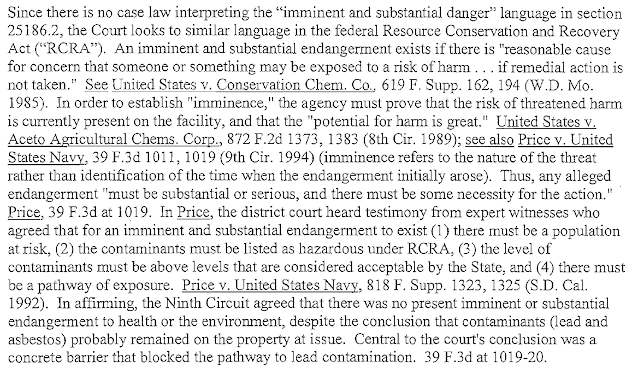What I really like about doing this blog are the rabbit holes I get sent down.
This series of posts resulted from a Los Angeles Times article on how California's Department of Toxic Substances has been "ineffectual" in protecting the environment. The evidence for this failure came in the form of this:
A quarter of California's 118 major hazardous waste facilities are operating on expired permits that may not meet current standards. In a conspicuous case, a battery recycler in Vernon whose lead and arsenic emissions have endangered the health of residents in southeast Los Angeles County has been smelting batteries for decades with only a temporary permit.I started my environmental career in California, and that's not the DTSC and California I know (and loved!).
So I dug into the complaint about Exide, which had a similar smelter recently shut down in Texas. Eight posts later, here I am, and I just now got around to reading the court documents posted by DTSC regarding the Exide facility.
A lot about what has been said about Exide's Vernon California facility troubles me. I expect the public to yell "shut it down, shut it down!" What I did not expect was the DTSC to kowtow to public pressure to the point where they would lead the public into a false determination of "imminent and substantial" harm.
Apparently the Judge - who overturned DTSC's cease order - thought so as well:
 |
| Source |
 |
| Source |
The facility serves as an example of when a permit should be revoked; it is on an interim status permit and has numerous air quality, solid waste and hazardous waste issues.What took place from 2006 to 2013?
The LA Times October 8, 2013 article regarding the consultant's report on DTSC's permit review process and the public hearing called on the same day it was submitted, concludes with the following:
The 115-page report also noted that representatives of many environmental groups believe that the department has "a strong bias toward industry at the expense of public health." Some in the hazardous-waste industry, meanwhile, told the authors that the Department of Toxic Substances Control allows "unreasonable opposition" from the public to stand in the way of permits even when objections are "not based on science or law."I found it interesting that these consultants would be aware of this dynamic and still make the statement that the Exide facility should serve "as an example of when a permit should be revoked."
Why?
What's the "science or law" that supports that? How is allowing Exide to continue to operate doing so "at the expense of public health?" These consultants bring up a 2002 consent order, arsenic air emissions, and the stormwater issue as their reason for having DTSC deny the permit. If the 2002 consent order was a problem it would have been addressed in the 2006 public notice giving the green light for the Part B RCRA Permit.
You have read my posts on the arsenic emissions so let's look at how the Judge saw the stormwater pipe issue:
 |
| Source |
 |
| Source |
What does the Judge say about the arsenic emissions?
 |
| Source |
Let's look at where Exide is located:
The nearest sensitive receptor, an Elementary School, is 1.9 miles away. In terms of risk to the public who live there, is the following concern valid?
Delores Mejia held a cardboard box of red-paint-splattered fake million-dollar bills, which she said represented blood money Exide has made at the expense of the largely working-class and minority community. (1)
If you remove that red dot from the map, what will change? Here again is what the Judge thinks about Exide:
What aggravates me on all of this is that DTSC has now painted themselves into a corner. They were wrong to claim imminent and substantial and the court told them so. One thing that I know about government folks who control agencies is that the do not like to be told they are wrong. If you think DTSC is going to back away now, I have a bridge that you might be interested in. They are going to look, and look, and look until they find something.
The DTSC, working with the SCAQMD will eventually shut Exide down. Their Bankruptcy will exacerbate their resolve to fight it and both these two agencies will nickle and dime them with technicalities. The DTSC especially. It got its hand slapped pretty hard by this judge and they will not take too kindly to backing off.
The red dot will be removed and the people in the area will not be made more safe, more healthy, or the environment more protected.
Next Post: If they only had a RCRA permit...Part 9 (End)
.


No comments:
Post a Comment